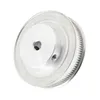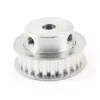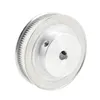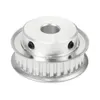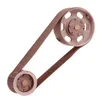A Timing Pulley is a specialized mechanical component designed for power transmission systems, ensuring synchronous movement between shafts through the use of toothed belts. These pulleys are critical in applications requiring precise positioning, high efficiency, and minimal slippage, such as in automotive engines, industrial machinery, robotics, and conveyor systems. Made from materials like aluminum, steel, or plastic, timing pulleys come in various sizes and tooth profiles to match specific operational needs, offering durability and reliability in diverse environments.
Understanding the parameters of timing pulleys is essential for selecting the right component for your system. Below are the primary specifications detailed in lists and a table for clarity.
| Parameter | Description | Common Values | Application Notes |
|---|---|---|---|
| Tooth Profile | Shape of the teeth (e.g., trapezoidal, curvilinear). | MXL, XL, L, H, T5, T10, AT5, AT10 | Choose based on belt type; e.g., T-series for high torque. |
| Outside Diameter (OD) | Overall diameter of the pulley. | 20mm to 500mm | Larger OD for higher speed reduction ratios. |
| Pitch Diameter (PD) | Diameter at the belt's pitch line. | Calculated as (Number of Teeth × Pitch) / π | Critical for determining speed ratios accurately. |
| Bore Tolerance | Precision of the inner bore size. | H7, H8 (ISO standards) | Ensures tight fit on shafts; use with keys or locks. |
| Weight | Mass of the pulley, affecting inertia. | Varies by material (e.g., 0.1kg to 5kg) | Lighter pulleys reduce system inertia for faster response. |
| Max RPM | Maximum rotational speed. | 1000 to 10,000 RPM | Depends on material and balance; higher for steel. |
| Temperature Range | Operating temperature limits. | -20°C to 150°C (varies by material) | Aluminum suits moderate temps; steel for extremes. |
What is a timing pulley used for?
A timing pulley is used in synchronous drive systems to transmit motion and power between shafts without slippage, ensuring precise positioning in applications like CNC machines, printers, and automotive engines.
How do I choose the right timing pulley size?
Select based on parameters such as pitch (match the belt), number of teeth (for desired speed ratio), bore size (fit the shaft), and material (consider load and environment). Refer to manufacturer charts for compatibility.
What materials are best for timing pulleys?
Aluminum is lightweight and resistant to corrosion, ideal for general use. Steel offers high strength for heavy loads, while plastic is economical for low-load, high-speed applications. Choose based on operational needs.
Can timing pulleys be customized?
Yes, they can be customized in terms of bore size, number of teeth, material, and hub type. Many suppliers offer made-to-order options for specific applications, such as unique keyways or flanges.
How do I maintain a timing pulley system?
Regularly inspect for wear on teeth and belts, ensure proper tension to prevent slippage, and lubricate if recommended (though many systems are maintenance-free). Avoid misalignment to extend lifespan.
What causes timing pulley failure?
Common causes include tooth wear from abrasion, misalignment leading to uneven load, excessive tension causing belt stretch, or material fatigue under high loads. Proper installation and selection mitigate these issues.
Are timing pulleys interchangeable with other pulleys?
No, they are designed specifically for toothed belts and require matching tooth profiles and pitches. Using a standard V-belt pulley can cause slippage and system failure.
What is the difference between a timing pulley and a sprocket?
A timing pulley works with a toothed belt for smooth, quiet operation, while a sprocket engages with a chain for higher torque but more noise and maintenance. Timing pulleys are preferred for precision applications.
How do I calculate the speed ratio with timing pulleys?
Divide the number of teeth on the driven pulley by the number on the driver pulley. For example, a 20-tooth driver and 40-tooth driven pulley give a 1:2 ratio, halving the speed and doubling torque.
Can timing pulleys handle high temperatures?
Yes, but it depends on the material. Steel pulleys can withstand up to 150°C or higher, while aluminum is limited to around 120°C. Plastic pulleys may deform above 80°C, so select based on environment.
